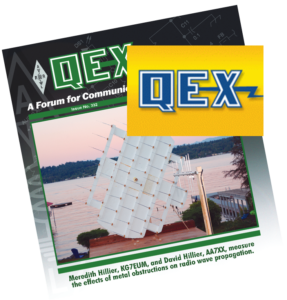 At W. Cardone Productions we have written a paper defining diode characterization for computer simulation which the editors of the QEX magazine have selected for publication.
At W. Cardone Productions we have written a paper defining diode characterization for computer simulation which the editors of the QEX magazine have selected for publication.
The QEX magazine is a publication of the ARRL (American Radio Relay League) and is published bi-monthly. The target audience is licensed amateur radio operators who are professionals in communications and electronics. The ARRL’s sister publication, the QST, is more widely known and targeted at the amateur radio community as a whole.
At this time it is unknown when the article will go to press but it is presumed to be in the July/August issue.
The article we have written targets a very specific area of conserved analog computer simulation. As of the time of this writing, there are literally dozens and dozens of conserved analog computer simulation applications either for sale or in the public domain. The grandfather of them all is Berkeley SPICE (Simulation Program with Integrated Circuit Emphasis) released into the public domain by the UC Berkeley about 1979. At that time SPICE was strictly a mainframe application but since that time with the advent of the technologically advanced personal computer, the program has migrated into many personal applications.
SPICE and SPICE-Like applications can be further broken down into two sub-categories: 1. SPICE knockoffs; and 2. Next-Gen applications. Next-Gen applications are too expensive for the small shop and are not nearly as numerous as the SPICE knockoffs. These include the Synopsys Saber tool, Ansys Simplorer tool, and the Siemens AIMEsim tool. The Next-Gen applications offer functionality going above and beyond what is available in SPICE and the SPICE knockoffs.
The SPICE knockoffs use the public domain Berkeley SPICE Fortran code and have transposed it into other programming languages but much of the machine language is retained as the original code has either been lost or is too time-consuming to re-generate. They have added generally a few (a very few) new models and very elaborate GUI interfaces.
What distinguishes a SPICE knockoff from a Next-Gen tool are the solution protocols. For a model to exist in SPICE the author of the model must solve for the model’s first derivative for each equation used. This makes it impossible for a single contributor to write a model. However, the Next-Gen tools use a linear approximation protocol solution that dispenses with the need for the first derivative. This may sound nice but it is not without problems which we won’t go into. But the advantage is that a single contributor can write his or her own models which is a HUGE advantage!
So anyway… what’s Wes’ paper about, anyhow? Well, here is the abstract:
The SPICE diode is capable of very high fidelity with respect to a published current-voltage (IV) profile for a reference ambient temperature. However, industry-standard released characterizations are designed to satisfy a wide range of ambient temperatures and consequently leave much to be desired at ambient temperatures such as 25oC. This paper will show what the SPICE model is and how to solve for its DC characterization parameters. A model so characterized will nearly superimpose itself over the published IV profile for simulations at its reference ambient temperature. It is recommended that the amateur radio operator electronic hobbyist download and use LTSpice . LTSpice is free and has relatively sophisticated features making it compete with many of the very expensive industrial implementations of SPICE and SPICE-like computer simulation tools.
Re-stated, it is a standard industry practice to characterize a diode for simulation to perform with minimal error across a wide range of ambient temperatures. This means that the model is going to depart significantly at the most common temperature, the ambient. In this paper, we show you how to characterize published performance at the ambient temperature. The price you pay, however, is that the industry standard model will do better for extreme ambient temperatures.
